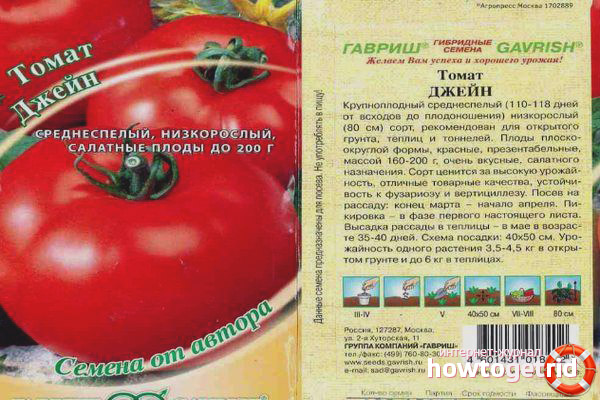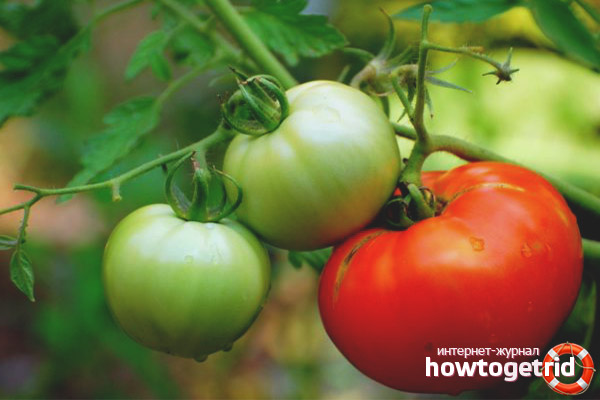The content of the article
Jane tomato is without a doubt one of the best tomato varieties. He is loved by many summer residents for the simplicity of cultivation and care, his taste will delight even the most picky gardener. Despite its unpretentiousness, it is still worth familiarizing yourself with the characteristics of the variety before growing. Knowing the little nuances will allow you to achieve a better harvest. The variety is suitable for cultivation in places with short summers and cool climates.
Characteristics
Tomato belongs to the group of vegetables not late ripening, but rather average. You can eat it as early as 119 days from the appearance of seedlings. Unpretentious vegetable feels great both in the greenhouse and in the open garden. Its bushes are low, about 80 centimeters in height.
The plant bears fruit in large quantities, several tomatoes appear simultaneously on one bush. Fruits are round in shape, slightly flattened in length.
The weight of the crop from one bush is 4 kilograms (open bed) or 6 kilograms (greenhouse, greenhouse). The weight of one tomato sometimes reaches 190 grams. Sour, but it does not in the least spoil the excellent taste of Jane. Tomatoes are well suited for raw consumption. The pulp of the vegetable is dark red and fleshy. The skin is dense.
Harvested on the seventh day from the start of ripening.
Preparing and planting seeds
Sowing seeds for seedlings is recommended in late February, a maximum in mid-March, that is, about 60 days before planting in open ground. The seeds are planted not deeply, 1-2 centimeters into the soil, so watering is possible only from the spray gun, otherwise the seeds will float to the surface. After sowing, the container is covered with glass, maintaining a temperature of 23-25 degrees.
Providing a sufficient amount of sunlight is desirable from the moment of germination. In the shade, young shoots can stretch out, fall and simply die.
Tip
Additionally, you can check the seeds for germination, for this:
- From all available seeds, select 10 pieces in a chaotic manner.
- Take a container with a lid and cover its bottom with a piece of cloth (the cloth should be wet).
- On top of the fabric, lay out the seeds already processed in manganese, cover with another damp cloth, and then the lid.
- Place the container with seeds under the radiator or other warm, but not hot place. The optimum temperature is up to 28 degrees.
- Watch the fabric. Do not allow it to dry out or increase humidity. With proper observation and care, on the fifth day, white roots will appear from the seeds. Based on the number of seedlings, you can understand how many seedlings will need to be laid to get the right amount of plants.
Features of storage and cultivation
Since the bush is small, it will be important to plant them not in a high greenhouse, but in small shelters. The variety does not require pinching of the crown and spraying. It is worth tying up bushes, because under the weight of numerous fruits it can break. This is done using a wooden column that sticks into the ground, and any rope or piece of cloth.
Tomatoes grown in a greenhouse should be immediately processed or eaten, their skin is thinner than those that grew on the street. Street vegetables are very well stored and tolerate transportation.
Note! For planting tomatoes in the future, you can take seeds from those already grown by you, they absolutely do not lose their qualities.You should not use only those seeds that are more than a year old, most likely half of them simply will not sprout.
In order for the harvest to please you at the end of summer, you need to follow some rules:
- Tomatoes are a photophilous culture, so make a choice in favor of well-lit areas, which will contribute to excellent productivity.
- Do not forget about watering. Bushes need water regularly, and when they begin to bear fruit, watering should be intensified, more water will be required.
- If you want to get fruits with high palatability, do not remove them from the bush and place them in a dark place for ripening. Leave them on the plant until the end of ripening.
- Fertilize the vegetable only at an early stage of development, then this procedure is excluded until the ovaries form.
- If it’s warmer on the street, but there is still a threat of the return of cold weather, do not rush to transfer the tomatoes to the street, they may freeze at night.
Bushes are resistant to disease. But treatment may be required in late summer and only for the prevention of late blight.
Video: Jane variety tomatoes











Submit